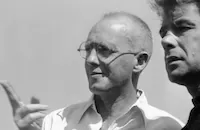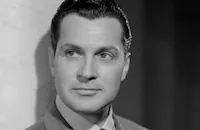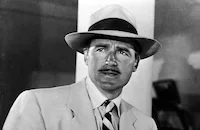Five Came Back

Brief Synopsis
Cast & Crew
John Farrow
Chester Morris
Lucille Ball
Wendy Barrie
John Carradine
Allen Jenkins
Film Details
Technical Specs

Synopsis
In Los Angeles, nine passengers board the Silver Queen, a plane piloted by Bill Brooks bound for Panama City. Bill's human cargo consists of Crimp, a detective determined to return his prisoner, the anarchist Vasquez, to a South American capital to collect a $5,000 dollar reward; wealthy Judson Ellis, who is eloping with his secretary, Alice Melbourne; the elderly Professor Henry Spengler and his wife Martha; Tommy, a gang chief's small son; his chaperone Pete, a gunman; and Peggy Nolan, a woman of the streets. When a heavy storm forces the plane down in a dense jungle, the voyagers' true natures emerge as Bill and his co-pilot Joe labor to repair the craft. Under the twin threats of an impending attack by natives and the realization that the group may be permanently stranded, Crimp becomes a menacing bully and Ellis reveals himself to be a spoiled, cynical drunk, whereas Vasquez demonstrates the humanitarianism which drove him to anarchy. As the days wear on, Peggy becomes a substitute mother to little Tommy, thus winning Bill's respect, and Alice slowly realizes that she is in love with Joe. On the twenty-third day, the plane is repaired, but it can only carry five passengers. With the native drums threatening attack, Crimp and Pete disappear into the jungle and are slain by Indians. As the drums grow more ominous, Vasquez seizes the gun and proclaims that because the return to civilization means certain death to him, only he is objective enough to decide who will escape. Thus, the elderly professor and his wife, who are at the end of their lives, remain behind, as well as Ellis, who is shot as he grabs for the gun. As Vasquez, the professor and Martha gaze skyward, Tommy, Peggy, Bill, Alice and Joe ascend the skies to safety to begin new lives.

Director

John Farrow
Cast

Chester Morris

Lucille Ball

Wendy Barrie

John Carradine

Allen Jenkins

Joseph Calleia

C. Aubrey Smith

Kent Taylor

Patric Knowles

Elisabeth Risdon
Casey Johnson

Dick Hogan
Crew
Jerry Cady
Richard Carroll
Robert D'agostino
Millard Kaufman
Lee Marcus
Harry Marker
Nicholas Musuraca
Argyle Nelson
Van Nest Polglase
Sam Ruman
Robert Sisk
Edward Stevenson
Douglas Travers
John E. Tribby
Vernon Walker
Roy Webb
Nathanael West

Photo Collections
Videos
Movie Clip



Trailer
Hosted Intro
Film Details
Technical Specs

Articles
Five Came Back
No one expected Five Came Back to be anything more than a clichéd and formulaic B-picture but director John Farrow turned it into something much more engaging and entertaining. He must have liked it because he also directed the 1956 remake, Back from Eternity. For one thing, there is not a wasted scene in the film's brisk seventy-five minute running time. The soon-to-be-stranded characters are introduced quickly but in vivid little vignettes so that you have an immediate impression of who they are and their backstory. For instance, secretary Alice Melbourne (Wendy Barrie) is eloping with her employer Judson Ellis (Patric Knowles); Crimp (John Carradine), a law-enforcer, is escorting Vasquez (Joseph Calleia), a wanted murderer to justice; Peggy (Lucille Ball), a woman of questionable virtue, is running away from a sordid situation, etc. There is also a little boy on board and an elderly couple and part of the escalating tension hinges on that final moment when a select group of people get to fly to possible safety or remain behind to become souvenirs of the headhunters.
Another virtue of the film is the sharp dialogue written by Jerry Cady, Nathanael West and Dalton Trumbo. West, who is best known as the author of The Day of the Locust, Miss Lonelyhearts and several other acclaimed novellas, penned numerous screenplays for Fox, Republic, RKO and other studios but most of them were undistinguished B-movies. Trumbo, however, became one of Hollywood's most acclaimed screenwriters and the year after he collaborated on Five Came Back, he won his first Oscar® nomination for Best Writing/Screenplay for Kitty Foyle [1940]. Jerome Cady was no slacker either and would eventually earn an Oscar® nomination for Best Writing/Original Screenplay for 1944's Wing and a Prayer. So it's hard to know who contributed what to the script and dialogue. Regardless of that, the film crackles with a street-smart banter and sense of humor that harkens back to the Warner Bros. urban melodramas of the thirties. A case in point is the scene where Peggy, Ball's character, and Bill (Chester Morris), one of the pilots, have their first conversation as Bill plays a slot machine in a Panama airport lounge.
Peggy: "That's one racket you can't win at." Bill: "How do you know?"
Peggy: "I used to know the man who makes them."
Bill: "You should know how to beat them."
Peggy: "I do. Don't play 'em."
For some of the cast members such as Wendy Barrie, Chester Morris, Joseph Calleia and C. Aubrey Smith, Five Came Back was made well past their career peaks but for others such as director John Farrow, Lucille Ball and John Carradine, it was merely a stepping stone to greater things. Ball, in particular, would emerge triumphant after being miscast and undervalued for years by both RKO and MGM when she became the star of one of the biggest hits in the history of television, I Love Lucy (1951-57). But she was still just a struggling contract player on the set of Five Came Back and the filming was more of an ordeal than pleasurable. For one thing, Farrow had a reputation for being a tyrannical and often verbally abusive director and, during the shoot, Ball and her director clashed numerous times. According to Charles Higham in Lucy: The Real Life of Lucille Ball, "Rain delayed the production for several days, the actor John Carradine fell ill, and Farrow's insistence on long rehearsals and lineups proved distracting to everyone. Despite the many irritations of the work - the problem of dealing with Farrow, fending off the crude advances of Chester Morris, and the physical work of the jungle locations - Lucy managed to cope. However, she was fretful and sickly during the weeks of production, and at one stage had an unpleasant shock: She was leaning against the trunk of a jungle tree imported to the sound stage, which had supposedly been carefully checked for any possible insect life, when two large black spiders crawled out of a hole and dropped on her head. She screamed uncontrollably, and had to be assisted off the set. Everybody laughed: she was furious."
In the end, Ball had the last laugh since she was the one cast member most often singled out in reviews of Five Came Back. The picture was well-received also with the New York Times proclaiming it "a rousing salute to melodrama, suspenseful as a slow-burning fuse, exciting as a pinwheel, spectacularly explosive as an aerial bomb."
Some Additional Trivia:
- RKO acquired a Capeles C-12 aircraft built in 1928 for a Greek-American syndicate as the main prop in Five Came Back.
- In addition to the later film, co-star John Carradine appeared in eight other films in 1939, among them John Ford's Stagecoach (one of Carradine's best roles), Jesse James, directed by Henry King, and The Three Musketeers, a comedic version of the Dumas classic headlined by The Ritz Brothers and Don Ameche.
- Wendy Barrie's association with gangster Bugsy Siegel (she was his mistress for a time) helped hasten the end of the actress's Hollywood career. After appearing in Submarine Alert in 1943, she didn't appear in movies again until her cameo role in George Cukor's It Should Happen to You (1954).
- After Five Came Back, John Farrow would quickly graduate to bigger budgeted pictures with name casts such as A Bill of Divorcement (1940) with Maureen O'Hara and Adolphe Menjou, Wake Island, the Best Picture Oscar® nominee of 1942, and The Big Clock (1948), a first-rate suspense thriller starring Charles Laughton and Ray Milland.
Producer: Robert Sisk
Director: John Farrow
Screenplay: Jerome Cady, Dalton Trumbo, Nathanael West, Richard Carroll (story)
Cinematography: Nicholas Musuraca
Film Editing: Harry Marker
Art Direction: Van Nest Polglase
Music: Roy Webb
Cast: Chester Morris (Bill Brooks), Lucille Ball (Peggy Nolan), Wendy Barrie (Alice Melbourne), John Carradine (Mr. Crimp), Allen Jenkins (Pete), Joseph Calleia (Vasquez).
BW-75m. Closed captioning.
by Jeff Stafford
SOURCES:
Lucille by Kathleen Brady
Lucy: The Real Life of Lucille Ball by Charles Higham
The RKO Girls
The Film Encyclopedia by Ephraim Katz

Five Came Back
Quotes
Trivia
Notes
In 1956, director John Farrow remade this film for RKO as Back from Eternity, starring Robert Ryan and Anita Ekberg.
















